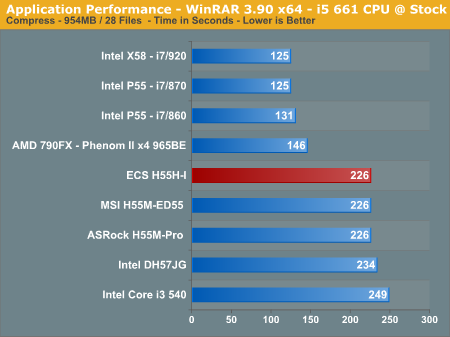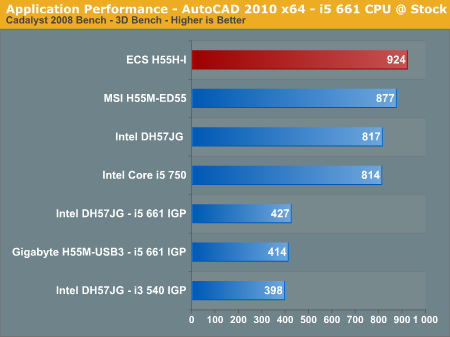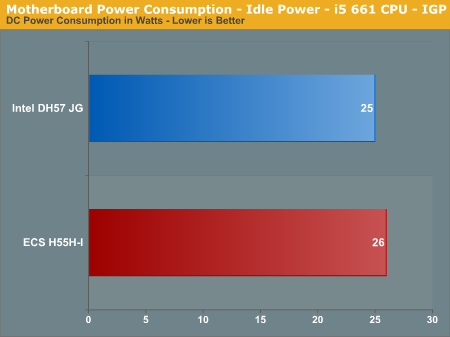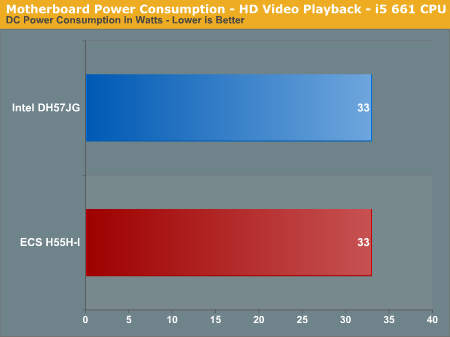ECS H55H-I Review: Mini-ITX at a Sensible Price
by Rajinder Gill on May 6, 2010 6:59 AM EST- Posted in
- Motherboards
Let’s start off with the basic compares:



The H55H-I performs admirably in our benchmark suite, placing mid to top tier in every benchmark we threw at it.
Power Consumption
Our power consumption testing utilizes the same batch of components under similar circumstances in a bid to monitor variances between idle and CPU load conditions. We install the vendor supplied power saving utilities on each board (when available) and enable power saving modes that don't involve any kind of underclocking or CPU core frequency modulation in order to run an apples to apples comparison.
ATX PSU switching losses are absent from our figures because we monitor power consumption directly at the DC rails of the PSU. These figures measure only the CPU, motherboard and memory DC power draw and exclude any other peripherals, such as cooling fans and hard drives etc. AC power consumption at the wall will be anywhere from 15~40% higher than these figures depending upon the efficiency of your power supply.


The DC power consumption figures are almost identical to Intel's DH57JG in every day usage.
Overclocking
The inclusion of over-voltage options for CPU VCore, VTT and VDIMM open the door to a reasonable level of overclocking with Clarkdale processors:

4GHz is attainable on the H55H-I, surpassing the Intel DH57JG.
We added a 0.1V voltage boost to CPU VCore (ignore the 2.20V shown in the CPU-Z screenshot, it's around 1.23V), VTT and VDIMM for the above screenshot and proceeded to pass two hours of Linpack without a glitch. The BIOS does allow you to push higher if you want to, although we think it’s probably safe to stick at a 4GHz limit given the perceived abilities of ECS’ VRM (3 Phase for VCC using 30 amp FETs, giving a theoretical 90 amp maximum under a best case scenario). Bear in mind that if running with the IGP active, you’ll be limited somewhere around 165BCLK anyway, because there is no way to change the IGP clock ratio in BIOS or increase voltage to the graphics core.
For those of you wondering about Lynnfield overclocking, do yourself a favor and don't take any of the four core processors above stock on this board - there's not enough power on tap to sustain the load.










67 Comments
View All Comments
nubie - Thursday, May 6, 2010 - link
The industrial market uses (used?) ISA cards.Try Soyo, Supermicro, and Jetway for industry boards.
Powerlurker - Thursday, May 6, 2010 - link
http://adek.com/ATX-motherboards.htmlI needed to spec one a couple years ago for a piece of lab equipment (I too work in a chemistry lab). It looks like this is the website for the motherboard manufacturer. http://www.commell.com.tw/Product/SBC/P4BWA.HTM
nubie - Thursday, May 6, 2010 - link
How could I forget Commell,Thanks :)
kmmatney - Friday, May 7, 2010 - link
I've purchased several of the ADEK boards to support some old ISA motion controllers we have. The motherboards are around $300, while a new motion controller (these are quite advanced) would have cost about $4000. They work great!Earthmonger - Thursday, May 6, 2010 - link
Really, it is. I could previously count the number of socket 1156 ITX boards on one hand. This ECS is a welcome addition."However, if you're thinking of overclocking with this board, we'd say that ECS is a couple of BIOSes away from a glowing recommendation"
What ITX board would you recommend for overclocking, then? 'Cause I'm always thinking about it. Where's that EVGA ITX powerhouse at? lol
Rajinder Gill - Thursday, May 6, 2010 - link
Hi,Unfortuantely, all mini-ITX boards are limited in one way or another. Either by voltage options (insufficent current handling capacity), and/or the need of some BIOS polish as in the case of ECS.. I'm hoping we see someone put a 180amp capable VRM on one of these baords soon...lol
regards
Raja
MadMan007 - Thursday, May 6, 2010 - link
Yes that would be nice and I don't buy the 'limited space' argument either. There are plenty of good overclocking microATX boards that don't use a ton of space for VRMs. I was hoping DFI would push things in this area but not yet...maybe since they are supposedly focusing on smaller form factors going forward they will.JonnyDough - Thursday, May 6, 2010 - link
Well, not quite legacy free. Isn't that a VGA connector? :)DanNeely - Thursday, May 6, 2010 - link
Mostly it matters for people doing low level OS development because PS2 requires much less software support than USB. If you're not hacking the linux kernel/porting it to new hardware it, along with RS232 are only really needed for high price hardware interfaces.lwatcdr - Thursday, May 6, 2010 - link
PS/2 ports and legacy serial and parallel ports can be a very important.Remember this is a Mini-ITX board. A good number of these end up in industrial settings.
Things like CNC machines, and lab equipment use good old serial and parallel ports to interface. They may also have a custom front panel that uses a PS/2 interface.
Even floppy's are still used on some systems like that and some of the software for them even runs under dos!
For a nettop or desktop you are correct. They less than useful but there is a large market segment that will need them for a long time. BTW USB to serial converters tend to be crap.